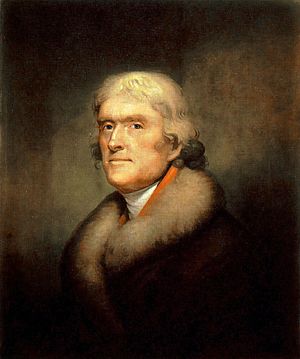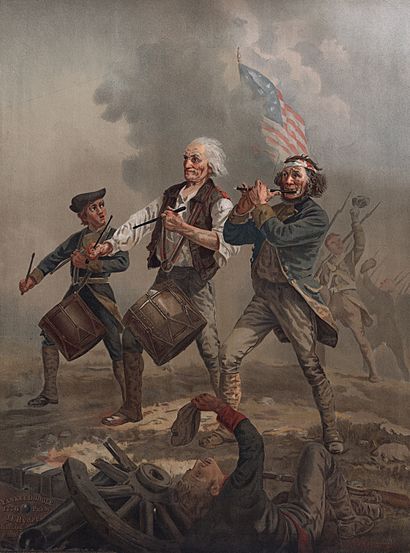Spirit of '76 (sentiment) facts for kids
The Spirit of '76 is a strong feeling of patriotism (love for one's country). It comes from the time of the American Revolution in 1776. This spirit is all about wanting to be free and make your own choices. It was a key idea behind the U.S. Declaration of Independence.
Contents
What Does the Spirit of '76 Mean?
The idea of the Spirit of '76 was deeply explored by Thomas Jefferson. He was one of the main writers of the Declaration of Independence. According to writings from Monticello, Jefferson believed the Declaration promised a new era of freedom. This was not just for America, but for other nations too.

Jefferson thought the American Revolution, starting on July 4, 1776, would inspire people everywhere. It would help them see their rights and fight against unfair rulers. He believed it would lead to equality for everyone.
Thomas Jewett wrote that the Spirit of '76 was an "intangible something." It was shown through the beliefs and actions of the Founding Fathers. Thomas Jefferson is a great example of this spirit.
Jefferson and the Second Continental Congress believed the Spirit of '76 included "self-evident truths." These truths meant everyone is "created equal." They also have "certain unalienable rights." These rights include "life, liberty, and the pursuit of happiness."
The New York Times explained that Jefferson believed the "spirit of '76" rejected strong government power. Especially power coming from far away, like London or Washington. He thought states should have more power. But John Marshall believed the Constitution created a strong national government. This government could make laws for all Americans.
The Adam Smith Institute says the Spirit of '76 was about wanting personal freedom. This means freedom in how we act and how we deal with others. They believe bringing back this spirit can help keep the government limited. This helps protect people's freedom.
How the Spirit of '76 Has Been Used
In 1806, a judge in Philadelphia said, "General and individual liberty was the spirit of '76." This shows how important freedom was.
The Famous Painting: The Spirit of '76
The Spirit of '76 is a very famous painting. It was made by Archibald Willard, an artist from Ohio. He was also a veteran of the Civil War. The painting was first called Yankee Doodle. It was created in 1875 for the Centennial Exposition. This was a big celebration of America's 100th birthday.
Quick facts for kids The Spirit of '76 |
|
|---|---|
 |
|
| Artist | Archibald MacNeal Willard |
| Year | 1875 |
| Type | Oil |
| Location | Abbot Hall in Marblehead, Massachusetts |
The painting got its new name, "Spirit of '76," while on display in Boston. It was meant to be a bit funny at first. But Willard's father, who modeled for one of the figures, passed away. This made the painting more serious. It shows three soldiers from the American Revolutionary War. One soldier is hurt, but they keep marching with courage. You can see this painting at Abbot Hall in Marblehead, Massachusetts.
Other Mentions of the Spirit
Elizabeth Cady Stanton wrote about the Spirit of '76. She mentioned it when she went to Philadelphia for the Centennial Exposition in 1876.
In 1843, historian Mellen Chamberlain met Levi Preston. Preston was 91 and a veteran of the American Revolution. Chamberlain asked him why he fought in the Concord Fight in 1775. He mentioned that histories said they fought against "intolerable oppression."
Preston replied that he didn't feel oppressed. He never saw the stamp tax papers. He also never drank tea, saying "the boys threw it all overboard." He explained that they always governed themselves and wanted to keep doing so. The British did not want them to.
In 1899, Eugene V. Debs gave a speech called Liberty. He said, "Manifestly, the spirit of '76 still survives." He believed the desire for freedom was still strong.
The Library of Congress has a 1915 postcard. It shows George Washington saying, "Did I Save My Country for This!" The postcard used the Spirit of 1776 to support women's right to vote.
L. Lloyd MacDonald wrote that in 1776, a small group of brave men changed the meaning of independence. He called this a "vibrant spirit of heart and mind known to many as 'the Spirit of '76.'"
Ira Moore gave a speech in 1822 called American Independence. He wrote that the speech was for smart, patriotic farmers. Its goal was to teach republican ideas. It also aimed to keep alive the patriotic Spirit of '76.
John Patrick Diggins wrote about Abraham Lincoln. Lincoln saw the Declaration of Independence as a very important, almost sacred, document. He believed the Spirit of '76 gave America its meaning and purpose in history.
In 2009, John P. Resch wrote that Revolutionary War veterans became symbols of the Spirit of '76. They showed what American character was like.
The Spirit of '76, along with events like the Battle of the Alamo, represents important moral and spiritual ideas. These ideas can inspire people and societies.
In 2011, Daren Jonescu said the Tea Party was a modern example of the Spirit of 1776. Others have linked this spirit to conservative ideas today.
Ron Grossman, writing for the Chicago Tribune, felt the true meaning of the Spirit of '76 is sometimes lost. He noted that modern Fourth of July celebrations might miss the original point.
In 2013, Scott Rasmussen wrote that Americans still embrace the Spirit of '76. He said people believe they have the right to make their own choices. This is true as long as it doesn't harm others' rights. This attitude, described by Thomas Jefferson, still challenges political leaders today.

